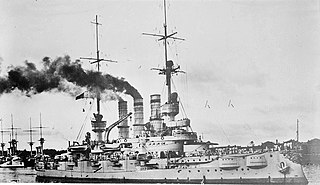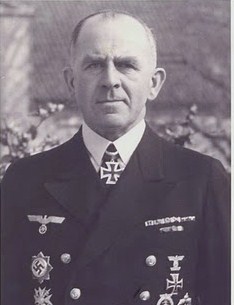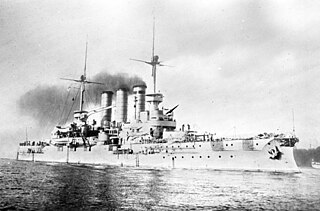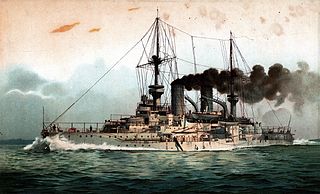
The Kriegsmarine was the navy of Nazi Germany from 1935 to 1945. It superseded the Imperial German Navy of the German Empire (1871–1918) and the inter-war Reichsmarine (1919–1935) of the Weimar Republic. The Kriegsmarine was one of three official branches, along with the Heer and the Luftwaffe, of the Wehrmacht, the German armed forces from 1935 to 1945.

The Reichsmarine was the name of the German Navy during the Weimar Republic and first two years of Nazi Germany. It was the naval branch of the Reichswehr, existing from 1919 to 1935. In 1935, it became known as the Kriegsmarine, a branch of the Wehrmacht; a change implemented by Adolf Hitler. Many of the administrative and organizational tenets of the Reichsmarine were then carried over into the organization of the Kriegsmarine.

The armored cruiser was a type of warship of the late 19th and early 20th centuries. It was designed like other types of cruisers to operate as a long-range, independent warship, capable of defeating any ship apart from a battleship and fast enough to outrun any battleship it encountered.
Deutschland is the German-language word, or endonym, for Germany. Deutschland may also refer to:

SMS Schlesien was one of five Deutschland-class pre-dreadnought battleships built for the German Kaiserliche Marine between 1904 and 1906. Named after the German province of Silesia, Schlesien was laid down at the Schichau-Werke shipyard in Danzig on 19 November 1904, launched on 28 May 1906, and commissioned on 5 May 1908. She was armed with a battery of four 28 cm (11 in) guns and had a top speed of 18 knots. The ships of her class were already outdated by the time they entered service, as they were inferior in size, armor, firepower, and speed to the revolutionary new British battleship HMS Dreadnought.
Hermann Bauer was a German naval officer who served as commander of the U-boat forces of the Kaiserliche Marine during World War I. In addition to his World War I career, Bauer is well known as the author of the book Das Unterseeboot, a treatise on the design and operation of U-boats, which was later translated into English by Hyman G. Rickover. Rickover's translation became a basic text for the US submarine service.

Otto Ciliax was a German naval officer who served in the navies of the German Empire, the Weimar Republic and Nazi Germany. As an admiral during World War II, he commanded the German battleships. He was a recipient of the Knight's Cross of the Iron Cross.
Aktien-Gesellschaft Vulcan Stettin was a German shipbuilding and locomotive building company. Founded in 1851, it was located near the former eastern German city of Stettin, today Polish Szczecin. Because of the limited facilities in Stettin, in 1907 an additional yard was built in Hamburg. The now named Vulcan-Werke Hamburg und Stettin Actiengesellschaft constructed some of the most famous civilian German ships and it played a significant role in both World Wars, building warships for the Kaiserliche Marine and the Kriegsmarine later.

SMS Braunschweig was the first of five pre-dreadnought battleships of the Braunschweig class built for the German Kaiserliche Marine. She was laid down in October 1901, launched in December 1902, and commissioned in October 1904. She was named after the Duchy of Brunswick. The ship was armed with a battery of four 28 cm (11 in) guns and had a top speed of 18 knots. Like all other pre-dreadnoughts built at the turn of the century, Braunschweig was quickly made obsolete by the launching of the revolutionary HMS Dreadnought in 1906; as a result, her career as a front-line battleship was cut short.

SMS Mecklenburg was the fifth ship of the Wittelsbach class of pre-dreadnought battleships of the German Imperial Navy. Laid down in May 1900 at the AG Vulcan shipyard in Stettin, Germany, she was finished in May 1903. Her sister ships were Wittelsbach, Zähringen, Wettin, and Schwaben; they were the first capital ships built under the Navy Law of 1898, championed by Admiral Alfred von Tirpitz. Mecklenburg was armed with a main battery of four 24-centimeter (9.4 in) guns and had a top speed of 18 knots.

SMS Wettin was a pre-dreadnought battleship of the Wittelsbach class of the German Kaiserliche Marine. She was built by Schichau Seebeckwerft in Danzig. Wettin was laid down in October 1899, and was completed October 1902. She and her sister ships—Wittelsbach, Zähringen, Schwaben and Mecklenburg—were the first capital ships built under the Navy Law of 1898. Wettin was armed with a main battery of four 24 cm (9.4 in) guns and had a top speed of 18 knots.

SMS Prinz Adalbert was an armored cruiser built in the early 1900s for the Imperial German Navy. She was named after Prince Adalbert of Prussia, former Commander-in-Chief of the Prussian Navy, and was the lead ship of her class.

SMS Victoria Louise was the lead ship of her class of protected cruisers, built for the German Imperial Navy in the late 1890s. She was laid down at the AG Weser shipyard in 1895, launched in March 1897, and commissioned into the German fleet in February 1899. She was named after Princess Victoria Louise, the daughter of Kaiser Wilhelm II. The ship was armed with a battery of two 21 cm guns and eight 15 cm guns and had a top speed of 19.2 knots.

SMS Schwaben was the fourth ship of the Wittelsbach class of pre-dreadnought battleships of the German Imperial Navy. Schwaben was built at the Imperial Dockyard in Wilhelmshaven. She was laid down in 1900, and completed in April 1904. Her sister ships were Wittelsbach, Zähringen, Wettin and Mecklenburg; they were the first capital ships built under the Navy Law of 1898, championed by Admiral Alfred von Tirpitz. Schwaben was armed with a main battery of four 24-centimeter (9.4 in) guns and had a top speed of 18 knots.

SMS Deutschland was the first of five Deutschland-class pre-dreadnought battleships built for the German Kaiserliche Marine. The ship was armed with a main battery of four 28 cm (11 in) guns in two twin turrets. She was built at the Germaniawerft shipyard in Kiel, where she was laid down in June 1903 and launched in November 1904. She was commissioned on 3 August 1906, a few months ahead of HMS Dreadnought. The latter, armed with ten large-caliber guns, was the first of a revolutionary new standard of "all-big-gun" battleships that rendered Deutschland and the rest of her class obsolete.

Hans-Jürgen "Hansjürgen" Rudolf Reinicke was a Kapitän zur See, commander of heavy cruiser Prinz Eugen, in Nazi Germany's Kriegsmarine during the Second World War and recipient of the Knight's Cross of the Iron Cross.

SMS Habsburg was a pre-dreadnought battleship built by the Austro-Hungarian Navy in 1899. The lead ship of the Habsburg class was launched on 9 September 1900. In 1903 and 1904, Habsburg and her sister ship Árpád conducted training exercises in the Mediterranean Sea. In 1906 and 1907, Habsburg was transferred to the III Battleship Division. One of her superstructure decks was removed to reduce weight and to modernize the vessel in 1910.

Edgar Quinet was an armored cruiser of the French Navy, the lead ship of her class. She and her sister ship, Waldeck-Rousseau, were the last class of armored cruiser to be built by the French Navy. Edgar Quinet was laid down in November 1905, launched in September 1907, and completed in January 1911. Armed with a main battery of fourteen 194-millimeter (7.6 in) guns, she was more powerful than most other armored cruisers, but she had entered service more than two years after the first battlecruiser—HMS Invincible—had rendered armored cruisers obsolescent.

The 15 cm SK L/40 was a German naval gun that was used as secondary armament on pre-dreadnought battleships, protected cruisers and armored cruisers of the Imperial German Navy in World War I. It was also used as a coast-defence gun during World Wars I and II.
Fritz Krauss was a German naval officer, most recently a Konteradmiral in the World War II. Between 16 August 1944 – 22 July 1945, Fritz Krauss was Director of Department of Naval Intelligence, specifically 3 SKL/MND IV of the German Navy.



















